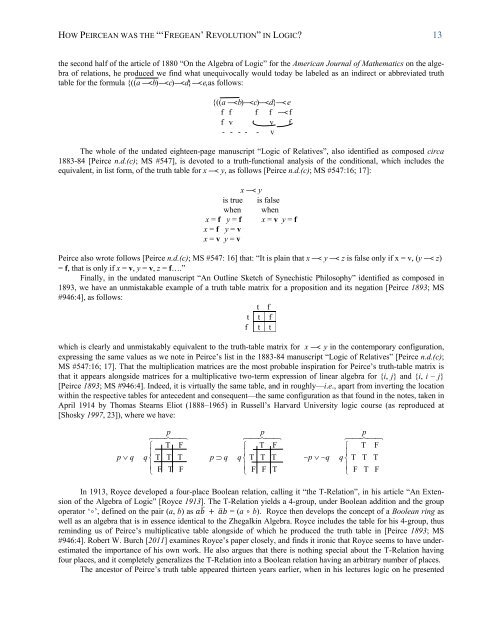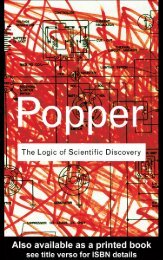Create successful ePaper yourself
Turn your PDF publications into a flip-book with our unique Google optimized e-Paper software.
HOW PEIRCEAN WAS THE “‘FREGEAN’ REVOLUTION” IN LOGIC? 13<br />
the second half of the article of 1880 “On the Algebra of Logic” for the American Journal of Mathematics on the algebra<br />
of relations, he produced we find what unequivocally would today be labeled as an indirect or abbreviated truth<br />
table for the formula {((a ―< b) ―< c) ―< d} ―< e, as follows:<br />
{((a ―< b) ―< c) ―< d} ―< e<br />
f f f f ―< f<br />
f v v f<br />
- - - - - v<br />
The whole of the undated eighteen-page manuscript “Logic of Relatives”, also identified as composed circa<br />
1883-84 [Peirce n.d.(c); MS #547], is devoted to a truth-functional analysis of the conditional, which includes the<br />
equivalent, in list form, of the truth table for x ―< y, as follows [Peirce n.d.(c); MS #547:16; 17]:<br />
x ―< y<br />
is true is false<br />
when when<br />
x = f y = f x = v y = f<br />
x = f y = v<br />
x = v y = v<br />
Peirce also wrote follows [Peirce n.d.(c); MS #547: 16] that: “It is plain that x ―< y ―< z is false only if x = v, (y ―< z)<br />
= f, that is only if x = v, y = v, z = f….”<br />
Finally, in the undated manuscript “An Outline Sketch of Synechistic Philosophy” identified as composed in<br />
1893, we have an unmistakable example of a truth table matrix for a proposition and its negation [Peirce 1893; MS<br />
#946:4], as follows:<br />
t f<br />
t t f<br />
f t t<br />
which is clearly and unmistakably equivalent to the truth-table matrix for x ―< y in the contemporary configuration,<br />
expressing the same values as we note in Peirce’s list in the 1883-84 manuscript “Logic of Relatives” [Peirce n.d.(c);<br />
MS #547:16; 17]. That the multiplication matrices are the most probable inspiration for Peirce’s truth-table matrix is<br />
that it appears alongside matrices for a multiplicative two-term expression of linear algebra for {i, j} and {i, i – j}<br />
[Peirce 1893; MS #946:4]. Indeed, it is virtually the same table, and in roughly—i.e., apart from inverting the location<br />
within the respective tables for antecedent and consequent—the same configuration as that found in the notes, taken in<br />
April 1914 by Thomas Stearns Eliot (1888–1965) in Russell’s Harvard University logic course (as reproduced at<br />
[Shosky 1997, 23]), where we have:<br />
p � q<br />
p<br />
�����<br />
� T F<br />
�<br />
q � T T T p � q<br />
�<br />
� F T F<br />
p<br />
�����<br />
� T F<br />
�<br />
q � T T T ~p � ~q<br />
�<br />
� F F T<br />
p<br />
�����<br />
� T F<br />
�<br />
q � T T T<br />
�<br />
� F T F<br />
In 1913, Royce developed a four-place Boolean relation, calling it “the T-Relation”, in his article “An Extension<br />
of the Algebra of Logic” [Royce 1913]. The T-Relation yields a 4-group, under Boolean addition and the group<br />
operator ‘�’, defined on the pair (a, b) as ��� � ��� = (a � b). Royce then develops the concept of a Boolean ring as<br />
well as an algebra that is in essence identical to the Zhegalkin Algebra. Royce includes the table for his 4-group, thus<br />
reminding us of Peirce’s multiplicative table alongside of which he produced the truth table in [Peirce 1893; MS<br />
#946:4]. Robert W. Burch [2011] examines Royce’s paper closely, and finds it ironic that Royce seems to have underestimated<br />
the importance of his own work. He also argues that there is nothing special about the T-Relation having<br />
four places, and it completely generalizes the T-Relation into a Boolean relation having an arbitrary number of places.<br />
The ancestor of Peirce’s truth table appeared thirteen years earlier, when in his lectures logic on he presented





